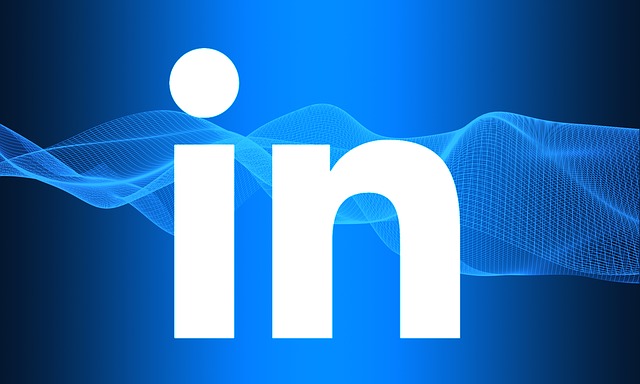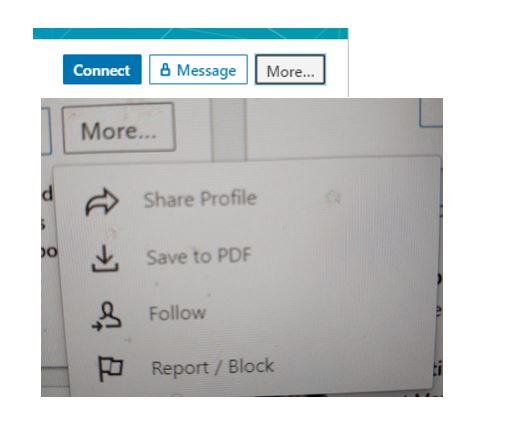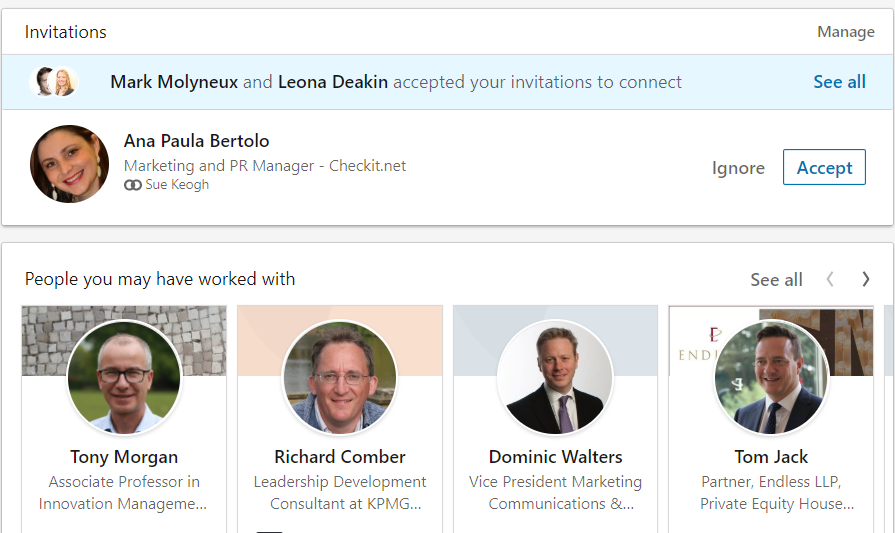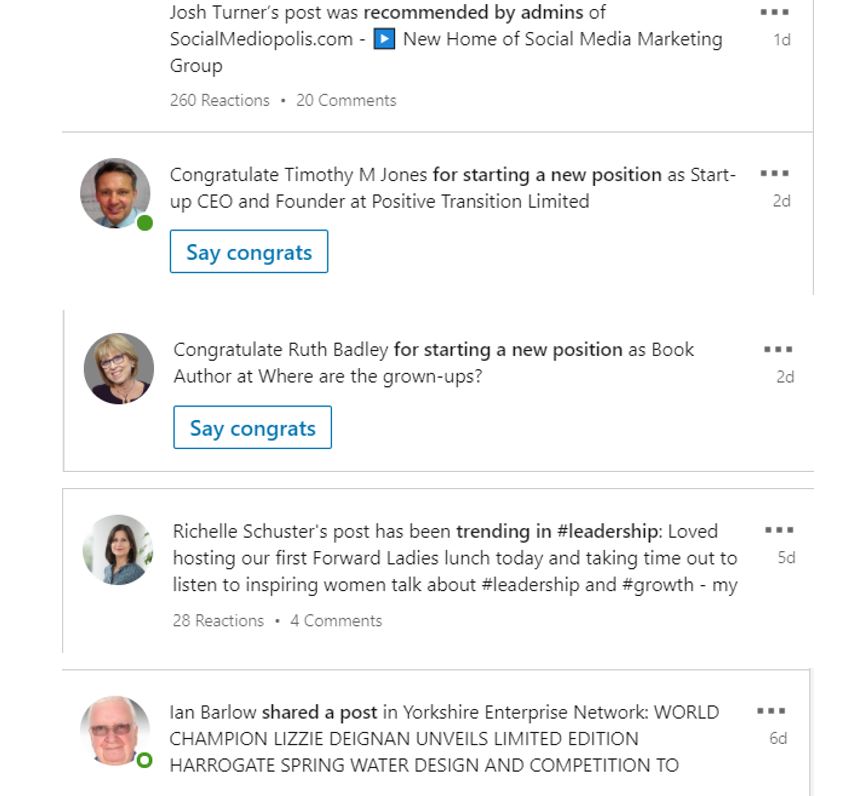7 inside secrets to making LinkedIn really work
15 July 2019 By Victoria Tomlinson

Last week I ran a workshop for some of EY’s most senior partners who will be retiring in the next year or two – on LinkedIn and Strategic Networking.
It is a joy to be working in my old firm and a reminder of just how bright and interesting these people are – it was very motivating working with them!
At the end I asked what people had got out of the session and most talked about now having a structure to use LinkedIn. As one partner said, “I have been dabbling with LinkedIn for three years, now I have a focus of what I want to achieve and how I will do that”. Others talked about being less frightened of the platform as well as how to create a plan for their future and using LinkedIn to build their networks and start conversations that will help for life post the firm.
I wrote 8 LinkedIn essentials for a winning (unretirement) profile as a handout to the session. It struck me it would be a useful follow-on to cover the ‘how’ of using LinkedIn.
Build your target list as a starting point
The big issue about using any social media is you can spend hours faffing around aimlessly on it, wondering why everyone else is so excited. And all you seem to do is waste time.
So just as in any area of business, you need to use social media in a focused way – what do you want to achieve? The starting point is to build a target list of people who could help you with research, contacts and more. If you want a non-executive director role that might include executive search firms (specialising in NED roles), people you know who have been successful in getting these roles, chairs and chief executives you know who could talk about what makes a good NED from their perspective (which probably won’t be the same but gives you good insights!).
If you are starting a consultancy, your list would include people who are in your target sectors or who can refer and/or can give you insights about issues. And so on.
Get to know your targets before you meet
I would recommend having a target list of around 50 people. You will find – if they are relatively senior people – that a good number, probably a third, will not be that active on LinkedIn or have a good profile. It can take six months for some people I invite on LinkedIn to accept the invitation – which they do on a Saturday or Sunday morning. You can almost hear them thinking, ‘I must look at LinkedIn …’!
Click ‘follow’ for each of these people – you will then be notified every time they post information on their profile. That will tell you a bit about their interests, connections and it may even tell you what they are up to and information about the company and its successes.
You don’t have to be connected to someone to follow them, so this is a useful thing to do. And more recently, LinkedIn’s algorithms mean that when people do anything on LinkedIn it is only shared with 20% of their network. So you might miss things.
How do you follow someone on LinkedIn? If you go to their profile, there are three buttons near their name – Connect, Message and More. Click on ‘More’ and you will get a drop down box and can click on Follow. See the screengrabs below

Not everyone is active on LinkedIn
Just as you may only now be getting to grips with LinkedIn, don’t be put off if your targets are doing little. Do what you can with those who are active and if needed, build a larger/different target list with people who are active.
Create a regular slot to go on LinkedIn
This was the tip that partners found the most useful. Find a time in your diary when you can commit say half an hour to going on LinkedIn regularly. Ideally this would be once a week but if it’s every fortnight or even once a month, that is better than once in a blue moon!
When I started out using social media generally, I did this on a Saturday morning when I didn’t get distracted with other things. I typically set aside half an hour – but usually found an hour or two later I was still on! However, I never minded as I was learning so much in that time, always had a few interesting conversations and really built up confidence in this space.
Engage with your targets
When you go onto LinkedIn, click on ‘my network’ and ‘notifications’. You can see these here

Here is a screengrab of ‘my network’ today. It is telling me who has accepted my invitations, showing new invitations and also ‘people you may know’.

Things you may want to do
- Start a conversation with someone who has connected with you – especially if they are on your target list
- Accept or ignore the invitation. I used to be very selective about who I accepted invitations from. However, so many people now contact me without any message when they want to do business with us, I am just accepting pretty much all invitations!
It is also worth looking at who LinkedIn is suggesting you know. Its algorithms are very good at putting networks together and quite often I spot someone whom I don’t know but want to! In that case, I tend to do a cheeky message, “LinkedIn is suggesting we know each other – I don’t think we do, but I would love to know you! Can we connect?”
Next go to your Notifications. Here, LinkedIn posts when people have got new roles/promotions, articles by people you are following or if they think they will interest you, interesting posts in groups that you belong to and more.
You will find it also tells you if it is someone’s birthday – and this is a good reminder for you. DO NOT put your birthday on any social media site. It is giving away security to hackers.
Below are a few things showing on my notifications today.


If any of the notifications are about people on your target list, this is an opportunity to say congrats, offer help, find out more, share and more.
They say it takes seven touches to sell to someone – so all of these are useful networking tools to stay in touch or get to know key people in your target audience.
Share posts
One thing that worries people who work in regulated industries is posting information that may not break compliance rules. On the whole, I would say by the time you have reached a relatively senior level, trust your instincts on this. Don’t promote financial products or give advice to someone about their savings or pensions – but you wouldn’t?
But rather than diving in straight away to making your own comments and writing blogs, just start gently by commenting on and sharing other people’s posts.
As an example, I spotted a post about Tech Nation’s entrepreneur engagement managers. We just had a meeting with one, Jem Henderson, and were bowled over by her enthusiasm and support for our initiative – we are creating City Meetups to get experienced professionals mentoring tech scale-up businesses. I wanted to thank Jem so I commented how impressed we had been. It’s a genuine comment and thanks – but hopefully it’s a small step to help the relationship between us all.

Focus on other people, not yourself
The other recurring theme from the workshop was that to be successful, you need to focus more on the people you want to work with than yourself. For anyone who isn’t comfortable ‘selling yourself’ this helps enormously. You don’t need to talk about yourself, just to be interested in the other person and what their issues are – what problems do they have (that maybe you could solve!).
The same applies on LinkedIn. Be generous on LinkedIn. That doesn’t mean being smarmy but done well, social media brings out the best in all of us. Share, thank, like, respond, help, introduce. Not much about you here?! And this is far easier – and more effective – than trying to sell yourself. People will respond if you are generous and get to know you – and in due course, business will follow.
So those are the detailed, practical tips to using LinkedIn – do let me know if I have missed something you think is key.
And if you want help writing your LinkedIn profile – we can do that! Have a look at our services page.


